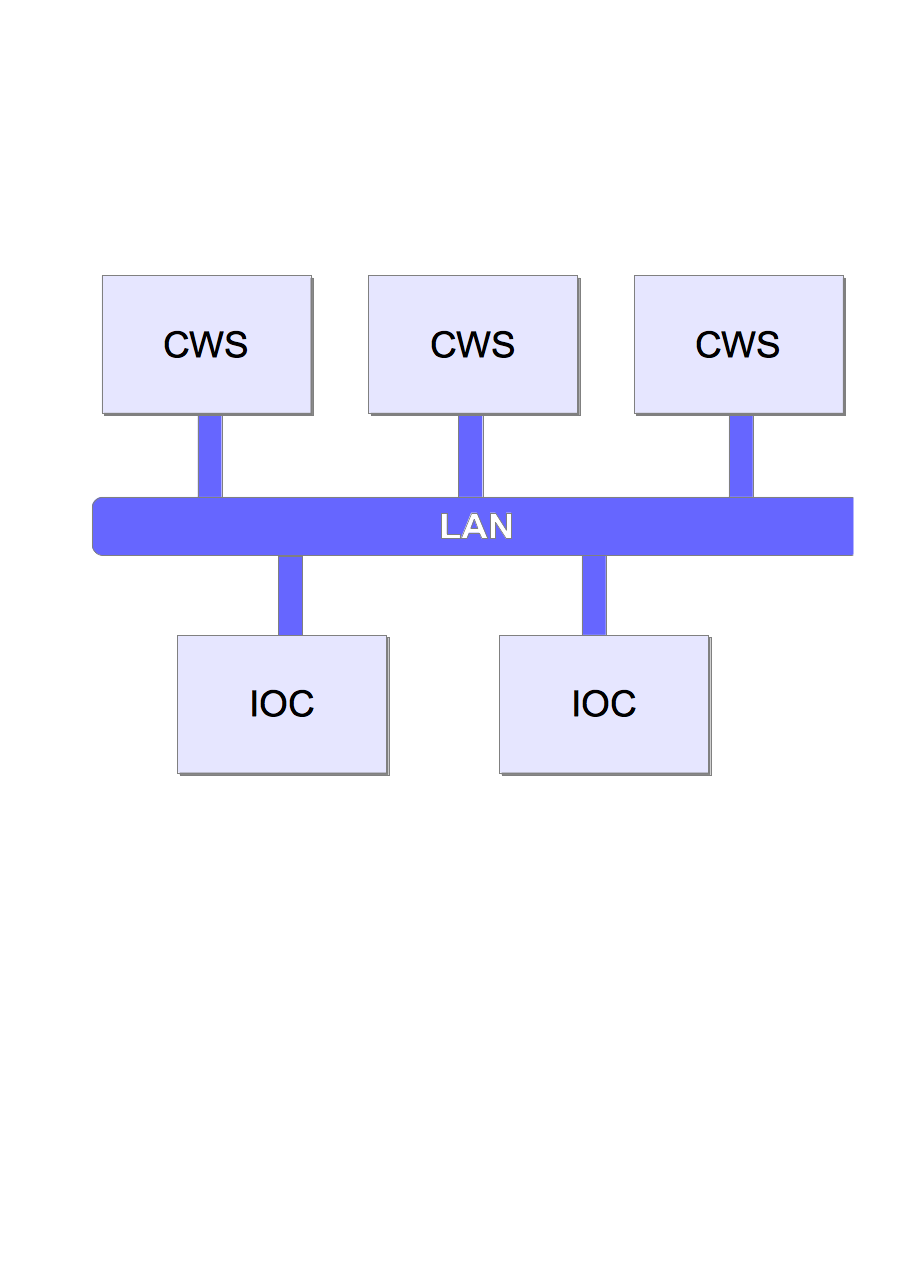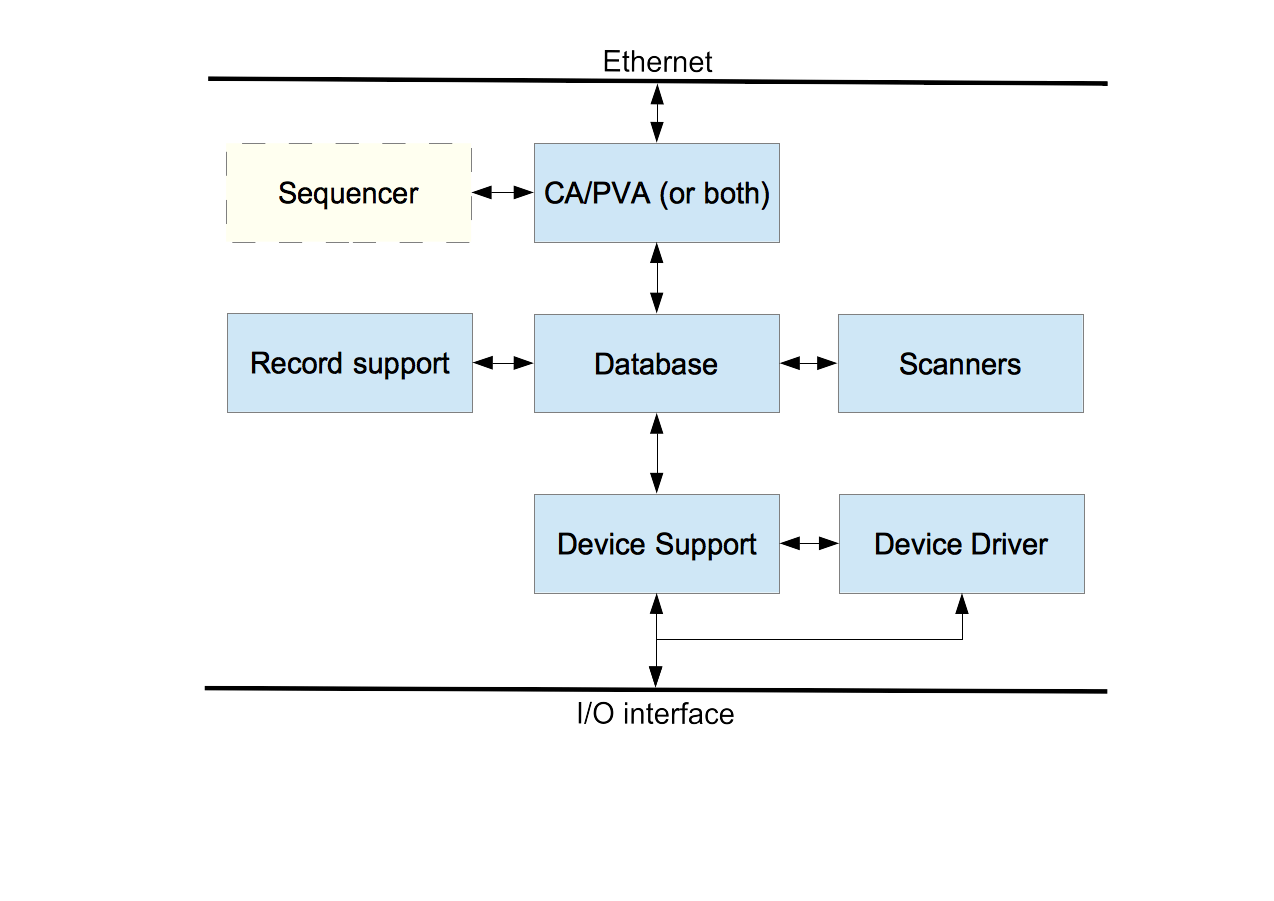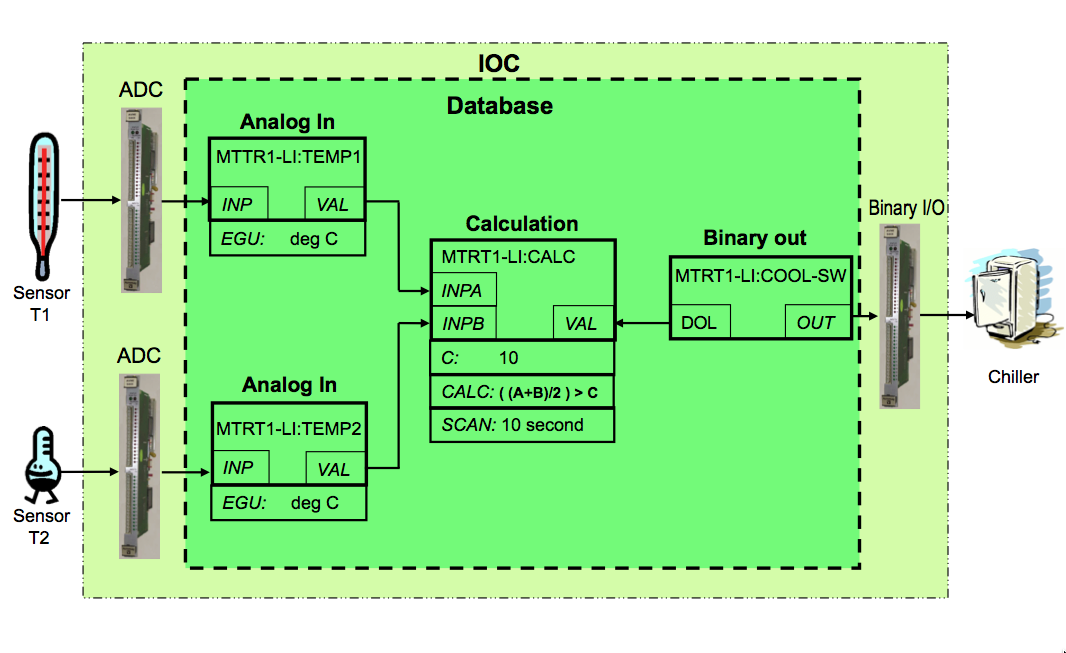
Broadly speaking, the EPICS toolset enables creation of servers and client applications. Servers provide access to data, reading or writing, locally or over a network. Reading and writing is often done to and from hardware connected to physical components, however data can also be produced or used elsewhere. Physical I/O, however is the central task of any control system, including EPICS.
Clients can display, store and manipulate the data. Client software ranges from (graphical and command line) user interface tools to powerful services for data management.
The basic components of an EPICS-based control system are:
IOC, the Input/Output Controller. This is the I/O server component of EPICS. Almost any computing platform that can support EPICS basic components like databases and network communication can be used as an IOC. One example is a regular desktop computer, other examples are systems based on real-time operating systems like vxWorks or RTEMS and running on dedicated modular computing platforms like MicroTCA, VME or CompactPCI. EPICS IOC can also run on low-cost hardware like RaspberryPi or similar.
CWS, or Client WorkStation. This is a computer that can run various EPICS tools and client applications; typical examples are user interface tools and data archiving. CWS can be desktop computer, a server machine or similar, and is usually running a “regular” (as opposed to real-time) operating system like Linux, Windows or MacOS.
LAN Local Area Network. This is just a standard Ethernet-based (or wireless) communication network that allows the IOCs and CWS’s to communicate.
A simple EPICS control system can be composed of one or more IOCs and Client WorkStations that communicate over a LAN (Figure 1). Separation of clients and servers makes configuration of the systems easier and also makes the system more robust. Clients and servers can be added to and removed from the system without having to stop the operation.

Figure 1. A simple EPICS control system structure.
In addition to these basic components of a “classical” EPICS control system, it is also possible to implement servers (aka services) for data that are not “process I/O” (real-time values from a controlled process) or attached to hardware. These other services can for example provide configuration or calibration data, or computing services like particle beam modeling. Since all the services “speak” the same protocol and exchange the same type of data structures, the data source is transparent to the client software (i.e., you do not need to know in advance where the data comes from or how it is obtained.) In this sense, the IOC can be regarded as a special type of server that handles process data and connects to real field hardware (in many cases, but not necessarily.)
The EPICS software components Channel Access (CA) and pvAccess (PVA) provide the protocols and structures that enable network transparent communication between client software running on a CWS and an arbitrary number of IOCs and other servers. More details about CA and PVA are provided in later chapters.
The basic attributes of EPICS are:
An EPICS IOC at its core is a software entity or a process that contains the following software components:
Let us briefly describe the major components of the IOC and how they interact.

Figure 2. EPICS IOC components.
The heart of each IOC is a process database. This database is memory resident (i.e., not stored on a hard disk or other permanent memory device) and has nothing to do with the more commonly known relational (aka SQL) databases.
The database defines the functionality of the IOC: what process data it provides, how is the data handled and stored. The database can contain any number of records, each of which belongs to a specific record type. The record type defines the type of data that the record handles and a set of functions that define how the data are handled. Record type-specific metadata, also known as “properties” is included in the records to configure and support the operation. For instance, an analog input (ai) record type supports reading in values from hardware devices and converting them into desired (engineering) units. It also provides limits for expected operating ranges and alarms when these limits are exceeded. EPICS supports a large and extensible set of record types, e.g. ai (Analog Input), ao (Analog Output), etc.
The metadata, known as “fields” is used to configure the record’s behavior. There are a number of fields that are common to all record types while some fields are specific to particular record types. Every record has a record name and every field has a field name. The record name must be unique across all IOCs that are attached to the same TCP/IP subnet, to enable the client software to discover any record on the subnet and to access its value and other fields.
record(ai, "Cavity1:T") #type = ai, name = “Cavity1:T”Figure 3. Example of an EPICS database record. Only a subset of fields is defined here.
Database records can be linked with each other. For example, records can retrieve input from other records, trigger other records to process, enable or disable records and so on.
By linking a combination of records together, the EPICS database becomes a programming tool. Using this, even very sophisticated functions can be achieved with the database. In addition, as this logic resides on the IOC, it is not dependent on any client software to work. By taking advantage of this, many client programs can be “thin” and just display or write the values in the database records. Figure 4 below illustrates a simple example of record linking: if the average temperature of the two sensors T1 and T2 is over 10 degrees, the chiller is switched on. This database contains four records: two analog inputs (ai), one binary output (bo) and one calculation (calc).

Figure 4. Example of record linking. From [2].
Data structures are provided so that the database can be accessed efficiently. Most software components do not need to be aware of these structures because they access the database via library routines.
Database scanning is the mechanism to process a record. Processing means making the record perform its task, for instance reading an I/O channel, converting the read value to engineering units, attaching a timestamp to the value or checking the alarm limits. How data are handled when a record is processed depends on the record type.
Four basic types of record scanning are provided: Periodic, Event, I/O Event and Passive. All these methods can be mixed in an IOC.
Access to the database does not require record type-specific knowledge; each record type provides a set of record support routines that implement all record-specific behavior. Therefore, IOCs can support an arbitrary number of records and record types. Similarly, record support contains no device specific knowledge, giving each record type the ability to have any number of independent device support modules. If the method of accessing the piece of hardware is more complicated than can be handled by device support, then a device driver can be developed. Sometimes splitting functionality between device support (when it is record type-specific) and a driver (when the code handles device-specific details) is a good practice.
Record types that are not associated with hardware do not need to have device support or device drivers. One example is a calculation (“calc”) record that reads its input from other records, performs a calculation and then (optionally) forwards the result to other records.
The IOC software design allows a particular installation and even a particular IOC within an installation to choose a unique set of record types, device types, and drivers. The remainder of the IOC system software is unaffected.
To give an overview of how the separation works, let us look at the tasks of the record support. Every record support module must provide a record processing routine to be called by the database scanners. Record processing consists of some combination of the following functions (all record types do not need all functions):
The same concept is applied to the device support and device driver modules: each support module has to define a set of functions so that it can become a part of the IOC software.
The mechanism to send notifications when a database value changes is called “database monitors”. The monitor facility allows a client program to be notified when database values change without having to constantly poll the database. These can be configured to specify value changes, alarm changes, and/or archival changes.
Database monitors are supported by the EPICS standard protocols Channel Access and pvAccess.
EPICS provides network transparent access to IOC databases by supporting the following network protocols for data exchange.
Channel Access is based on a client/ server model. Each IOC provides a Channel Access server that is able to establish communication with an arbitrary number of clients. Channel Access client services are available on both CWSs and IOCs. A client can communicate with an arbitrary number of servers.
The basic Channel Access client services are:
In addition to process variable values, any combination of the following additional information (“metadata”) may be requested:
Channel Access provides an IOC resident server, which waits for Channel Access search messages. These are UDP broadcasts that are generated by a Channel Access client (for example when an Operator Interface task starts) when it searches for the IOCs containing process variables it uses. This server accepts all search messages, checks to see if any of the process variables are located in this IOC, and, if any are found, replies to the sender with an “I have it” message.
Once the process variables have been located, the Channel Access client issues connection requests for each IOC containing process variables the client uses. The connection request server, in the IOC, accepts the request and establishes a connection to the client. Each connection is managed by two separate tasks: ca_get and ca_put. The ca_add_event requests result in database monitors being established. Database access and/or record support routines provide the value updates (monitors) via a call to db_post_event.
Each IOC provides a connection management service. If a Channel Access server fails (e.g. its IOC crashes) the client is notified and when a client fails (e.g. its task crashes) the server is notified. If a client fails, the server breaks the connection. If a server crashes, the client automatically re-establishes communication when the server restarts.
pvAccess is a modern replacement and an alternative to Channel Access available in EPICS 7. PvAccess adds a number of capabilities to EPICS that augment the set of services provided by Channel Access. With pvAccess, structured data can be transported with a high efficiency and is capable of handling big data sets; this has been achieved with a number of optimizations:
The basic pvAccess client services are similar to Channel Access, with a couple of additions:
For the IOC, an IOC resident server (qsrv) provides the interface to access the process database records. Basic access to a single PV provides the equivalent function to channel access. In addition, qsrv provides the possibilities to create data structures that combine data from different database records into structures that are transported as units. Since EPICS 3.16, the IOC core is able to guarantee atomic access to the records, meaning that the data in the structure that qsrv provides is guaranteed to be a result of a single processing (or better expressed, that the records do not change their values while qsrv is assembling the data structure.) This applies also to puts, meaning that all values are written to the addressed records before the records are processed. This way, coherence of parameters for an operation can be guaranteed.
Like in Channel Access, qsrv waits for search messages. The server accepts all (UDP) search messages, checks to see if any of the process variables are located in this IOC, and if any are found, replies to the sender with an “I have it” message.
In pvAccess, the process of how a client and a server establish the communication channel is slightly different from Channel Access and contains two stages. The first stage is exchanging introspection data. In this stage, the server communicates to the client the structure of the data to be exchanged. Both sides can then create the necessary placeholder structures for the communication. In the second stage the actual data can be exchanged, using the allocated data structures.
pvAccess provides a connection management service similar to Channel Access.
EPICS database and network transport
It should be noted that the access methods (pvAccess, Channel Access) do not provide access to the EPICS database as records. This is a deliberate design decision. This allows changes to be made in the database structures or new record types to be added without impacting any software that accesses the database via PVA or CA, and it allows these clients to communicate with multiple IOCs having differing sets of record types.
EPICS offers a range of tools and services that are executed on the client workstations. These can be divided into two groups based on whether or not they use Channel Access and/or pvAccess. CA/PVA tools are real time tools, i.e. they are used to monitor and control IOCs. These tools are not included in the EPICS “base” distribution and have to be downloaded separately. The tools are implemented in different languages and technologies and the users should select which tools are the best suited to their particular setup and infrastructure.
A large number of CA/PVA tools have been developed. The following are some representative examples.
As discussed in Chapter 2, EPICS is based on a “flat”, i.e., non-hierarchical set of records, which represent the Process Variables [ 1 ] of the control system. This has a number of pros and cons:
One can extend these lists and argue about them but the above are the most common.
There is no single truth saying that this model is better or worse than other conceivable models. It depends on the use case and how much weight is put on each different factor.
However, the new features in EPICS 7 have been added to mitigate the lack of abstraction and atomic actions. The structured data model in EPICS 7 allows construction of complex structures to represent abstract entities. Further, these entities can be built from the existing building blocks, thus the flexibility is retained; in a way this is even better than strict modeling because the abstraction can be added on top of the working system afterwards. Also, atomic actions – to the extent they can be implemented in a distributed system – have been added, thus removing the need of complicated workaround solutions.
Strictly speaking, each field of a record can also be considered as a process variable. However, for this discussion it is sufficient to take the simpler approach to equate a record with a PV.
© Copyright 2019, EPICS Controls.. Revision 89ee21d6 .